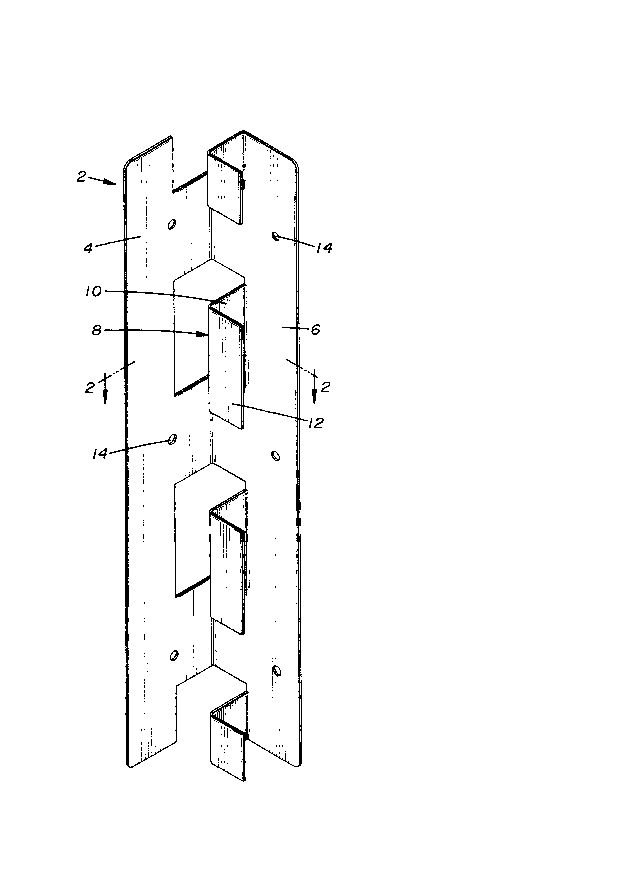Une partie des informations de ce site Web a été fournie par des sources externes. Le gouvernement du Canada n'assume aucune responsabilité concernant la précision, l'actualité ou la fiabilité des informations fournies par les sources externes. Les utilisateurs qui désirent employer cette information devraient consulter directement la source des informations. Le contenu fourni par les sources externes n'est pas assujetti aux exigences sur les langues officielles, la protection des renseignements personnels et l'accessibilité.
L'apparition de différences dans le texte et l'image des Revendications et de l'Abrégé dépend du moment auquel le document est publié. Les textes des Revendications et de l'Abrégé sont affichés :
| (12) Demande de brevet: | (11) CA 2191041 |
|---|---|
| (54) Titre français: | CORNIERE |
| (54) Titre anglais: | CORNER ANGLE CONNECTOR |
| Statut: | Réputée abandonnée et au-delà du délai pour le rétablissement - en attente de la réponse à l’avis de communication rejetée |
| (51) Classification internationale des brevets (CIB): |
|
|---|---|
| (72) Inventeurs : |
|
| (73) Titulaires : |
|
| (71) Demandeurs : |
|
| (74) Agent: | GOWLING WLG (CANADA) LLP |
| (74) Co-agent: | |
| (45) Délivré: | |
| (22) Date de dépôt: | 1996-11-22 |
| (41) Mise à la disponibilité du public: | 1997-05-23 |
| Requête d'examen: | 1998-10-22 |
| Licence disponible: | S.O. |
| Cédé au domaine public: | S.O. |
| (25) Langue des documents déposés: | Anglais |
| Traité de coopération en matière de brevets (PCT): | Non |
|---|
| (30) Données de priorité de la demande: | ||||||
|---|---|---|---|---|---|---|
|
The present invention is a one-piece corner connector for
structurally interconnecting in angular relation to each other
two flat panels of a given thickness. The connector has a
first connector sidewall oriented at an angle to a second
connector sidewall. The connector also has a reinforcing tab
which in relation with the first and second connector
sidewalls forms a pair of channels into which rectangular
panels are placed edgewise with each side face of each said
panel engaged by either a connector sidewall or a reinforcing
tab sidewall. Both side surfaces of each rectangular panel
are secured to the corner connector using screws, nails, nuts
and bolts, or an adhesive.
Note : Les revendications sont présentées dans la langue officielle dans laquelle elles ont été soumises.
Note : Les descriptions sont présentées dans la langue officielle dans laquelle elles ont été soumises.

2024-08-01 : Dans le cadre de la transition vers les Brevets de nouvelle génération (BNG), la base de données sur les brevets canadiens (BDBC) contient désormais un Historique d'événement plus détaillé, qui reproduit le Journal des événements de notre nouvelle solution interne.
Veuillez noter que les événements débutant par « Inactive : » se réfèrent à des événements qui ne sont plus utilisés dans notre nouvelle solution interne.
Pour une meilleure compréhension de l'état de la demande ou brevet qui figure sur cette page, la rubrique Mise en garde , et les descriptions de Brevet , Historique d'événement , Taxes périodiques et Historique des paiements devraient être consultées.
| Description | Date |
|---|---|
| Inactive : CIB de MCD | 2006-03-12 |
| Demande non rétablie avant l'échéance | 2001-11-22 |
| Le délai pour l'annulation est expiré | 2001-11-22 |
| Inactive : Abandon. - Aucune rép dem par.30(2) Règles | 2000-11-29 |
| Réputée abandonnée - omission de répondre à un avis sur les taxes pour le maintien en état | 2000-11-22 |
| Inactive : Dem. de l'examinateur par.30(2) Règles | 2000-05-29 |
| Modification reçue - modification volontaire | 1999-02-09 |
| Lettre envoyée | 1998-11-05 |
| Inactive : Renseign. sur l'état - Complets dès date d'ent. journ. | 1998-11-05 |
| Inactive : Dem. traitée sur TS dès date d'ent. journal | 1998-11-05 |
| Exigences pour une requête d'examen - jugée conforme | 1998-10-22 |
| Toutes les exigences pour l'examen - jugée conforme | 1998-10-22 |
| Demande publiée (accessible au public) | 1997-05-23 |
| Date d'abandonnement | Raison | Date de rétablissement |
|---|---|---|
| 2000-11-22 |
Le dernier paiement a été reçu le 1999-11-08
Avis : Si le paiement en totalité n'a pas été reçu au plus tard à la date indiquée, une taxe supplémentaire peut être imposée, soit une des taxes suivantes :
Veuillez vous référer à la page web des taxes sur les brevets de l'OPIC pour voir tous les montants actuels des taxes.
| Type de taxes | Anniversaire | Échéance | Date payée |
|---|---|---|---|
| TM (demande, 2e anniv.) - générale | 02 | 1998-11-23 | 1998-10-22 |
| Requête d'examen - générale | 1998-10-22 | ||
| TM (demande, 3e anniv.) - générale | 03 | 1999-11-22 | 1999-11-08 |
Les titulaires actuels et antérieures au dossier sont affichés en ordre alphabétique.
| Titulaires actuels au dossier |
|---|
| APA - THE ENGINEERED WOOD ASSOCIATION |
| Titulaires antérieures au dossier |
|---|
| EDWARD L. KEITH |